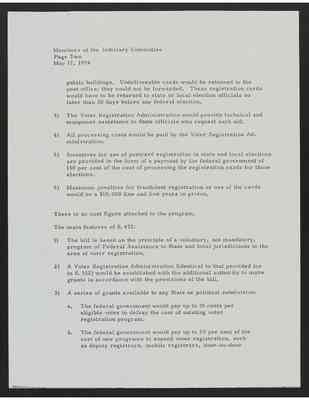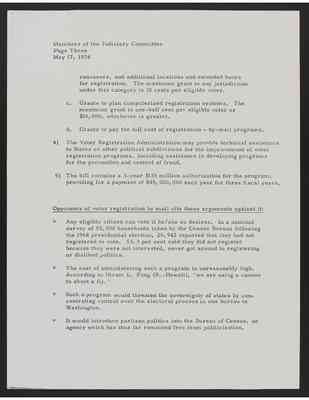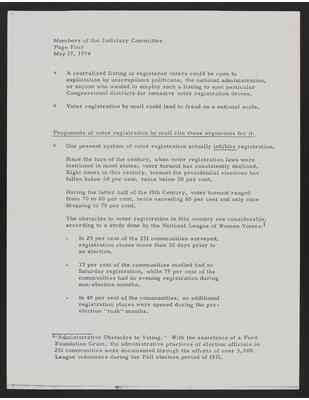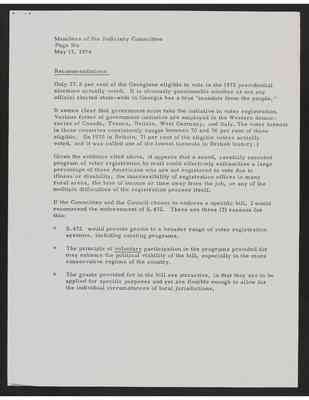Pages
11
Members of the Judiciary Committee Page Two May 17, 1974
public buildings. Undeliverable cards would be returned to the post office; they could not be forwarded. These registraion cards would have to be returned to state or local election officials no latter than 30 days before any federal election.
3) The Voter Registration Administration would provide technical and manpower assistance to State officials who request such aid.
4) All processing costs would be paid by the Voter Registration Administration.
5) Incentives for use of postcard registration in state and local elections are provided in the form of a payment by the federal government of 130 percent of the cost of processing the registration cards for those elections.
6) Maximum penaltites for fraudulent registration or use of the cards would be a $10,000 fine and five years in prison.
There is no cost figure attached to the program.
The main features of S. 472:
1) The bill is based on the principle of a voluntary, not mandatory, program of Federal Assistance to State and local jurisdictions in the area of voter registration.
2) A Voter Registration Administration (identical to that provided for in S. 352) would be established with the additional authority to make grants in accordance with the provisions of the bill.
3) A series of grants available to any State or political subdivision:
a. The federal government would pay up to 10 cents per eligible voter to defray the cost of exisiting voter registration program.
b. The federal government would pay up to 50 per cent of the cost of new programs to expand voter registration, such as deputy registrars, mobile registrats, door-to-door
12
Members of the Judiciary Committee Page Three May 17, 1974
canvasses, and additional locations and extended hours for registration. The maximum grant to any jurisdiction under ths category is 10 cents per eligible voter.
c. Grants to plan computerized registration systems. The maximum grant is one-half cent per eligible voter or $15,000, whichever is greater.
d. Grants to pay the full cost of registration - by - mail programs.
4) The voter Registration Administration may provide technical assistance to States or other political subdivisions for the improvement of voter registration programs, including assistance in developing programs for the prevention and control of fraud.
5) The bill contains a 3-year $135 million authorization for the program, providing for a payment of $45,000,000 each year for three fiscal years.
Opponents of voter registration by mail cite these arguments against it:
* Any eligible citizen can vote if he/she so desires. In a national survey of 50,000 households taken by the Census Bureau following the 1968 presidential election, 26, 942 reported that they had not registered to vote. 53.3 per cent said they did not register because they were not interested, never got around to registering or disliked politics.
* The cost of administrating such a program is unreasonalby high. According to Hiram L. Fong (R. - Hawaii), "we are using a cannon to shoot a fly."
* Such a program would threaten the sovereignty of states by concentrating control over the electoral process in one bureau in Washington.
* It would introduce partisan politics into the Bureau of Census, an agency which has thus far remained free from politicization.
13
Members of the Judiciary Committee Page Four May 17, 1974
* A centralized listing of registered voters could be open to exploitation by unscrupulous politicans, the national administration, or anyone who wanted to employ such a listing to spot particular Congressional districts for intensive voter registration drives.
* Voter registration by mail could lead to fraud on a national scale.
Proponents of voters registration by mail cite these arguments for it:
* Our present system of voter registration actually inhibits registration.
Since the turn of the centrury, when voter registration laws were instituted in most states, voter turnout has consistenetly declined. Eight times in this century, turnout for presidential elecitons has fallen below 60 per cent, twice below 50 per cent.
During the latter half of the 19th Century, voter turnout ranged from 70 to 80 per cent, twice exceeding 80 per cent and only once dropping to 70 per cent.
The obstacles to voter registration in this country are considerable, according to a study done by the National League of Women Voters:1
- In 29 per cent of the 251 communities surveyed, registration closes more than 30 days prior to an election.
- 77 per cent of the communities studied had no Saturday registration, while 75 per cent of the communities had no evening registration during non-election months.
- In 40 per cent of the communities, no additional registration places were opened during the pre-election "rush" months.
1 "Administrative Obstacles to Voting." With the assistance of a Ford Foundation Grant, the administrative practices of election officials in 251 communities were documented through the efforts of over 3,000 League volunteers during the Fall election period of 1971.
14
Members of the Judiciary Committee Page 4 May 17, 1974
- 54 per cent of the registraiton places were not accessible by convenient public transportation.
- 24 per cent of the registration places lacked convenient parking.
- 52 per cent of the registration places were not clearly indentified as a registration or elections office.
The study further indicates that the prospective registrant who is not frustrated by the above factors before he or she arrives at the registration office, may yet be discouraged by long line, confusing forms, unhelpful staff, and an unmet need for bilingual staff. Observations of 5,750 people attempting to register at approximately 300 registration places showed the 3 out of every 100 prospective registrants still left the registration place without being registered.
Of the 139 million potential voters in the 1972 presidentail election, only 77 million -- 56 per cent -- actually voted. Put another way, this means that 62 million votes were not cast, in an election which saw Presidential Nixon receive 47 million votes and Senator McGovern receiver 29 million votes. Clearly, the potential impact of 62 million votes is important in any election in which the actual voter turnout is only 77.
Of these Americans registered to vote in 1972, fully 87 per cent voted, supporting the idea that a substantial cause for low voter turnouts lies in the registration process.
* In answer to charges of fraud potential with registration by mail, proponenets point out the safeguards against fraud provided for in both bills, as well as the potential for fraud under the present system of registration.
* Voter registration would, in fact, remain the responsibility of State and local election officials. There are provisions in both bills which indicate this: S. 352 requires that registration cards be returned to local registration officials; @. 472 is founded on the principle of a voluntary program of Federal assistance to states and local jurisdictions.
15
Members of the Judiciary Committee Page Six May 17, 1974
Recommendations:
Only 37.8 per cent of the Georgians eligible to vote in the 1972 persidential elections actually voted. It is obviously questionable whether or not any official elected state-wide in Georgia has a true "mandate from the people."
It seems clear that goverment must take the initiatvie in voter registration. Various forms of government initiative are employed in the Western democracies of Canada, France, Britain, West Germany, and Italy. The voter turnout in those countries consistently ranges between 70 and 90 per cent of those eligible. (In 1970 in Britian, 71 per cent of the eligible voters actually voted, and it was called one of the lowest turnouts in British history.)
Given the evidence cited above, it appears that a sound, carefully executed program of voter registration by mail could effectively enfranchise a large percentage of those Americans who are not registered to vote due to illness or disability, the inaccessibility of registration offices in many rural areas, the loss of income or time away from the job, or any of the multiple difficulties of the registration process itself.
If the Committee and the Council choose to endorse a specific bill, I would recommend the endorsement of S.472. There are three (3) reasons for this:
* S.472 would provide grants to a broader range of voter registration systems, including existing programs.
* The principle of voluntary participation in the programs provided for may enhance the political viability of the bill, especially in the more conservative regions of the country.
* The grants provided for in the bill are attrative, in that they are to be applied for specific purposes and yet are flexible enough to allow for the individual circumstances of local jurisdictions.




